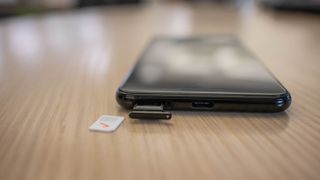Specs and performance
The Pixel 3
is a stable, fast-performing phone, though it isn't technically the
fastest we've tested in 2018. That really shouldn't matter to most
people.
It's powered by the latest Qualcomm Snapdragon 845 chipset and 4GB of RAM, when rival phones are up to 6GB and even 8GB of RAM. Likewise, Apple's A12 chipset beats the Snapdragon 845 handedly in all benchmarking tests.
Here's the good news, we didn't see slowdown from either the Pixel 3 or Pixel 3 XL. And the fact that Google owns the hardware and software should prove beneficial for smooth performance going forward.
The Geekbench 4 benchmarking tests gives the Pixel 3 a multi-core score of 8,336, finishing behind the Samsung Galaxy S9. Long-term, the 4GB of RAM may prove to be an issue, and it may drop frames compared to the next-level performance of the new Razer Phone 2 when gaming in 3D. But right now, we see nothing to dissuade the average user from buying this handset.

Namely, the onscreen home and back buttons have been visually downsized and come with different gestures attached to them. Tapping the iPhone X-like bottom home button bar (no longer a big circular button) sends you home, while swiping up on this flat bar opens the new recent menu to switch between apps. Swiping up further reveals the app drawer. The back button still works as normal, but is smaller than before.
All of this is in an effort to give the Google Pixel 3 extra screen real estate. It’s effective and you’ll get used to the changes, even if it’s painstaking at first. Your muscle memory needs time to adjust.
The trade-off is worth it, though it’s not Earth-shattering. The same goes for the time and the notification icons along the top, as the Android software is now fit for notched displays (even if this phone doesn’t have a screen cut out at the top).
The right-aligned volume slider interface (right next to the physical volume slider) makes it easier to wrap your head around whether you're adjusting call volume or media volume. Essentially, the slider is now dedicated to media, with a smaller on-screen button to toggle vibrate/ringer/silent. We’ve also had less issues with misguided screen rotation thanks to the new software. That's such a small, but meaningful change for everyday use.
Behind-the-scenes tools are even more groundbreaking. Adaptive battery life and adaptive brightness settings free you from having to worry about closing apps to save battery life and adjusting the brightness in different surroundings. Google’s machine-learning software does the heavy lifting by learning your behaviors and taking into account your environment.
We haven’t seen App Slices and App Actions from the operating system, but they’re shortcuts coming soon so that you can access apps (and content within those apps) faster. We’ll update this review as more changes from the the Google Pixel 3 software over the next year.
It's powered by the latest Qualcomm Snapdragon 845 chipset and 4GB of RAM, when rival phones are up to 6GB and even 8GB of RAM. Likewise, Apple's A12 chipset beats the Snapdragon 845 handedly in all benchmarking tests.
Here's the good news, we didn't see slowdown from either the Pixel 3 or Pixel 3 XL. And the fact that Google owns the hardware and software should prove beneficial for smooth performance going forward.
The Geekbench 4 benchmarking tests gives the Pixel 3 a multi-core score of 8,336, finishing behind the Samsung Galaxy S9. Long-term, the 4GB of RAM may prove to be an issue, and it may drop frames compared to the next-level performance of the new Razer Phone 2 when gaming in 3D. But right now, we see nothing to dissuade the average user from buying this handset.

Android Pie and apps
Android 9.0 Pie is now available for all Pixel phones, and the update comes out of the box with the Pixel 3 and Pixel 3 XL. It's a bit of a switch from previous Android operating systems in an effort to adapt to modern times.Namely, the onscreen home and back buttons have been visually downsized and come with different gestures attached to them. Tapping the iPhone X-like bottom home button bar (no longer a big circular button) sends you home, while swiping up on this flat bar opens the new recent menu to switch between apps. Swiping up further reveals the app drawer. The back button still works as normal, but is smaller than before.
All of this is in an effort to give the Google Pixel 3 extra screen real estate. It’s effective and you’ll get used to the changes, even if it’s painstaking at first. Your muscle memory needs time to adjust.
The trade-off is worth it, though it’s not Earth-shattering. The same goes for the time and the notification icons along the top, as the Android software is now fit for notched displays (even if this phone doesn’t have a screen cut out at the top).
The right-aligned volume slider interface (right next to the physical volume slider) makes it easier to wrap your head around whether you're adjusting call volume or media volume. Essentially, the slider is now dedicated to media, with a smaller on-screen button to toggle vibrate/ringer/silent. We’ve also had less issues with misguided screen rotation thanks to the new software. That's such a small, but meaningful change for everyday use.
Behind-the-scenes tools are even more groundbreaking. Adaptive battery life and adaptive brightness settings free you from having to worry about closing apps to save battery life and adjusting the brightness in different surroundings. Google’s machine-learning software does the heavy lifting by learning your behaviors and taking into account your environment.
We haven’t seen App Slices and App Actions from the operating system, but they’re shortcuts coming soon so that you can access apps (and content within those apps) faster. We’ll update this review as more changes from the the Google Pixel 3 software over the next year.




0 Comments